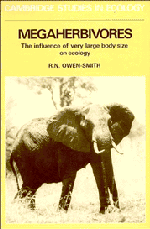Book contents
- Frontmatter
- Contents
- Preface
- 1 Prologue
- 2 Morphology, evolutionary history and recent distribution
- 3 Food and other habitat resources
- 4 Space–time patterns of habitat use
- 5 Body size and nutritional physiology
- 6 Body size and feeding ecology
- 7 Social organization and behavior
- 8 Life history
- 9 Body size and sociobiology
- 10 Body size and reproductive patterns
- 11 Demography
- 12 Community interactions
- 13 Body size and population regulation
- 14 Body size and ecosystem processes
- 15 Late Pleistocene extinctions
- 16 Conservation
- 17 Epilogue: the megaherbivore syndrome
- Appendixes
- References
- Index
2 - Morphology, evolutionary history and recent distribution
Published online by Cambridge University Press: 01 June 2011
- Frontmatter
- Contents
- Preface
- 1 Prologue
- 2 Morphology, evolutionary history and recent distribution
- 3 Food and other habitat resources
- 4 Space–time patterns of habitat use
- 5 Body size and nutritional physiology
- 6 Body size and feeding ecology
- 7 Social organization and behavior
- 8 Life history
- 9 Body size and sociobiology
- 10 Body size and reproductive patterns
- 11 Demography
- 12 Community interactions
- 13 Body size and population regulation
- 14 Body size and ecosystem processes
- 15 Late Pleistocene extinctions
- 16 Conservation
- 17 Epilogue: the megaherbivore syndrome
- Appendixes
- References
- Index
Summary
Introduction
Eight living species of terrestrial mammal fall into the megaherbivore category in terms of maximum body mass attained. These include two species of elephant, four rhinoceros species, and single species of hippopotamus and giraffe. In this chapter I describe the ecologically important features of their morphology, document their historic and present day geographic distributions, and outline their paleontological origins. This information serves as an essential background to the ecological topics that will form the subject of subsequent chapters.
Morphology
The most basic feature of significance to this book is size. How big do males and females of extant species of megaherbivore grow, in terms of height and weight? Size factors are frequently exaggerated in the literature, especially for large animals that are inconvenient to weigh. A distinction needs furthermore to be made between the asymptotic weights most typically reached by adult animals, and the maximum weights that might be reached by exceptional individuals. Weights may furthermore differ between different subspecies, and within populations in relation to prevailing resource abundance. Animals held in captivity may grow larger or smaller than their wild counterparts, depending on the adequacy of the diets that are provided to them.
Also of fundamental importance are the anatomic features functioning in the procurement and digestion of food. These include in particular the dentition and the structure of the digestive tract.
All large mammalian herbivores are dependent to some degree upon the agency of microbial symbionts for degradation of the cellulose in plant cell walls.
- Type
- Chapter
- Information
- MegaherbivoresThe Influence of Very Large Body Size on Ecology, pp. 6 - 29Publisher: Cambridge University PressPrint publication year: 1988



